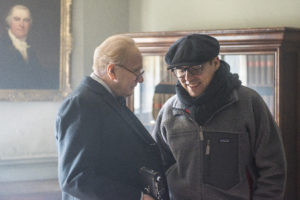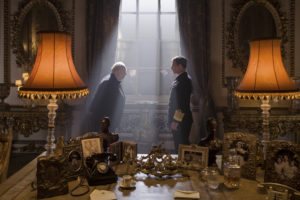
Cinematographer Bruno Delbonnel’s high contrast lighting and fast paced camera movement propel the story of Darkest Hour, illustrating an in depth study of Winston Churchill’s personality and character during the precarious weeks leading up to the Dunkirk evacuation during WWII.
This was Delbonnel’s first time working with director Joe Wright. Wright sent the script for Darkest Hour to Delbonnel, and then met him in Paris to talk about shooting the film. Initially Delbonnel was concerned about how to visually portray lots of “talking faces,” but there was “something about the Churchill personality that was interesting” to him, and inspired him to express the character’s eccentricities through lighting. “Light is much more interesting in terms of psychology. While studying the story I ask ‘How can I portray these kinds of emotions with lighting?’”
Churchill had a “duality of character, where he tries to hide, but he wants to be in the spotlight at the same time,” Delbonnel describes. He played with light to underscore the formidable leader’s persona. In the opening shot, the camera booms down and tracks back to reveal Churchill’s bowler hat. At first, “I kept the bowler hat in shadow. In the next scene he is lighting a cigar (in shadow) and then the shears open,” revealing Churchill in a shaft of light. For Delbonnel, the “intensity comes from the actors. I explain to the actors what I’m planning on doing with the lighting,” so they can move through light and shadow to express the character’s thoughts.

Delbonnel’s visual references mostly came from production designer Sarah Greenwood’s research and designs. “She did incredible research. We all have our own references. I collect photographs and go to museums, but the main references should come from the production designer and decorator.”
The color palette was mostly inspired by the look of London during the 1940s. They were still using coal for heating, so the buildings were covered with soot. “It was more about darkness and contrast than color,” added the DP. Historically, May of 1940 was unseasonably sunny, which fit in well with the contrasting lighting scheme, although it was overcast during production.
Delbonnel worked very closely with costume designer Jacqueline Durran. At the time, dark clothing was the norm. The war room, built on a stage, was a “muted, dirty cream color, with men wearing black suits, so there was already a given contrast.”
In the story, Churchill goes from being hated to becoming a hero. Delbonnel’s lighting highlights this arc in the House of Commons scenes, the set for which was built on a stage. The first time Churchill addresses the House, he moves between sunlight and shadow. Delbonnel lit the set with soft boxes and Arri Skypanels. The shafts of sunlight were created with 20K Fresnels and Molebeams. For his speech in the final Parliament scene, “he’s not hiding anymore. I used a 20K Molebeam on him.”
Churchill walks down a long corridor to meet King George in a Buckingham Palace scene, shot in a refurbished mansion in Northern England. During the blitz, all windows were blacked out at the palace. Originally written as a night scene, at Delbonnel’s suggestion, the corridor windows were left open, allowing shafts of daylight to make Churchill’s walk more dramatic. Delbonnel lit the scene with 18K ArriMax HMIs at full spot on cherry pickers shining through the windows. When Churchill enters King George’s parlor, the two windows are blacked out, with “small openings letting in only a little bit of light, so it was necessary to have practical lamps lit.” Delbonnel adds that he “doesn’t like it when all practicals are lit,” as it looks too obvious.
Although he doesn’t typically like using atmosphere, the DP added smoke to many scenes to “help lift the shadows and define the shafts of light. Churchill smoked 5 cigars a day, and everyone was smoking during war time, so we needed to see shafts of light.” Westminster Hall didn’t allow for smoke, so Delbonnel had to adjust his lighting.
To maintain the contrasting lighting theme in the war room, the filmmakers lit the faces more than the walls, trying to keep it as dark as possible. “I used a lot of muslin to bounce and blacks to make negative fill.” The primary sources were dimmable soft boxes, and 25 watt clear bulbs were installed in practical lamps.
During prep, Wright and Delbonnel spent two to three weeks discussing the script and sharing ideas. According to Delbonnel, they both had the same thoughts about the war room scenes. “How can we show 20 minutes of people sitting and talking around a table? How can we balance the whole story to make it interesting?” Together they took on the challenge of the long dialogue scenes by designing steadicam or tracking shots that would have the characters move through the maze-like set whenever possible. This contributes to the overall driving pace, yet very controlled framing of the film.
There are a lot of operatic overhead and crane shots looking down throughout the film that tell a whole story in one shot. One starts close on a soldier in an underground bunker, then lifts up through the “ground” into the sky, still looking straight down as bombs drop on the bunker. In one movement, we understand this soldier’s fear intimately and then see him die from the air, making the tragic situation universal. “The fluidity of the story is important – not to cut it up too much. I like to find a shot that tells the story.”
Darkest Hour is the third movie Delbonnel has shot digitally. “I chose the Arri Alexa SXT, because it is the only camera with an optical viewfinder. I cannot light from a monitor. I still use my meter, as well.” He rated the camera at 500 ISO, since “my eyes are calibrated to Kodak 5219.” He overexposes film a lot, but a little less in digital, to “see into the blacks. I can always add contrast later.”
Although Delbonnel is not a fan of tests, “because you never get the proper lighting and it’s not the actual set,” he did do make-up tests to find the right lighting for Gary Oldman’s prosthetic make-up and wig. “I used a very harsh light, just to see how the prosthetic on his face was holding up, and to not see the mesh. The make-up was amazing!”
Delbonnel is a big fan of wide lenses. “We knew we were going to shoot a lot of wide shots, and then go in very close to capture Churchill’s intensity. I love the 21mm, the 25mm and the 27mm, but if you want a feeling of claustrophobia with a wide lens, you need to bring the walls closer.” So Sarah Greenwood’s war room set had floating walls to accommodate.
Much of the film was shot at T8 to increase the depth of field. “Every piece of glass has some color in it. I wanted the cleanest image possible,” so he shot with no filters or diffusion, unlike Amelie, where he used 5 filters. On set, he worked closely with DIT Ryan March to adjust the color in the mid-tones. In grading, Delbonnel doesn’t like working with windows, but he does make adjustments to “bend the curve.”
Delbonnel believes that it’s a “mistake to take the script as a bible. It’s interesting to let it go. The movie has a life of it’s own.” In fact, he likes to think of a script as a piece of music. “Is it an important moment for lighting, actors, or something else?” In a symphony, sometimes the strings or other instruments are out front. In the same way, different elements of a film can be more important in a scene: It might be the dialogue, the set, or the lighting. “I like to let the actors play in and out of the light, as they want. Disturbing light is like bending strings in music, creating a visual dissonance. Light inhabits our mind, I try to control it.”





